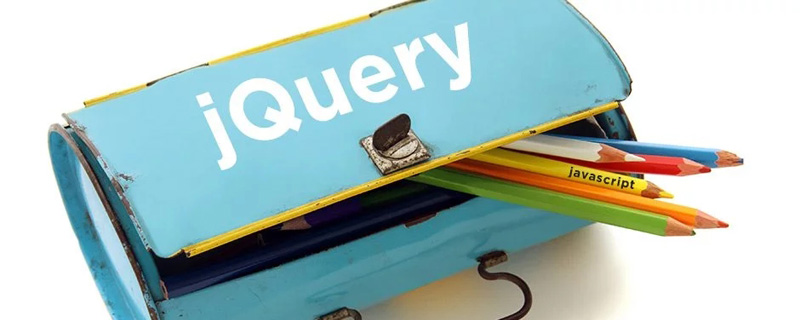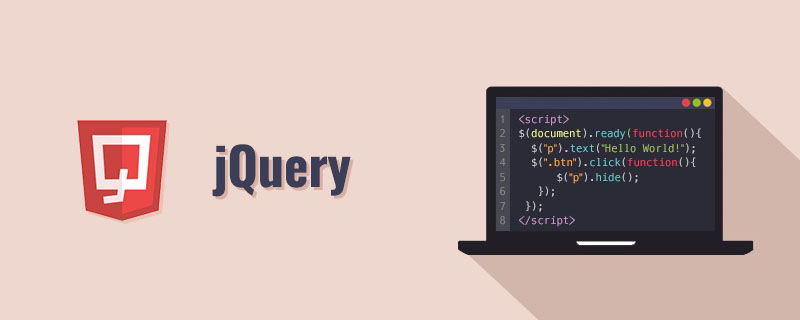 Web Front-end
Web Front-end JS Tutorial
JS Tutorial Detailed explanation of usage examples of queue() function queue in jQuery
Detailed explanation of usage examples of queue() function queue in jQueryThis article mainly introduces the example tutorial of the queue() function in jQuery. The queue() function provides convenience for the execution sequence control operation of the JavaScript function. It is required Friends can refer to the following
If the current jQuery object matches multiple elements: when getting the queue, only the queue on the first matching element is obtained; when setting the queue (replacement queue, append function), each matching Elements are set individually.
This function belongs to the jQuery object (instance). If you need to remove and execute the first function in the queue, use the dequeue() function. You can also use the clearQueue() function to clear the specified queue.
Syntax
This function was added in jQuery 1.2. The queue() function has the following two usages:
Usage 1:
jQueryObject.queue( [ queueName ] [, newQueue ] )
If no parameters are specified or only the queueName parameter is specified, it means to obtain the function queue with the specified name. If the newQueue parameter is specified, it means using the new queue newQueue to set (replace) all contents in the current queue.
Usage 2:
jQueryObject.queue( [ queueName ,] callback )
Add the specified function to the specified queue (end).
Note: All setting operations of the queue() function are for each element matched by the current jQuery object; all read operations are only for the first matching element.
Parameters
Please find the corresponding parameters according to the parameter names defined in the previous syntax section.
queueName: Optional/StringType specified queue name, the default is "fx" (indicating the standard animation effect queue in jQuery).
newQueue: Optional/Array type is used to replace the new queue content of the current queue.
callback: The function specified by the Function type will be appended to the queue. This function has a function parameter, which can be called to remove and execute the first function in the queue.
Return value
queue()The return value of the function is an Array/jQuery type. The type of the return value depends on what the current queue() function is executing. Get operation or set operation.
If the queue() function performs a setting operation (replacing the queue, appending a function), it returns the current jQuery object itself; if it is a retrieval operation, it returns the obtained function queue (array).
If the current jQuery object matches multiple elements, when reading data, the queue() function only uses the first matching element.
Example:
1. jQuery provides us with the queue() function to insert some of the code you need into a queue
$('#test-change1').toggle(function(){
$('#test-object1').hide('slow').queue(function(next){
$('#test-object1').appendTo($('#test-goal1'));
next();
}).show('slow');
},function(){
$('#test-object1').hide('slow').queue(function(next){
$('#test-object1').appendTo($('#test-origin1'));
next();
}).show('slow');
});2. Custom queue
$("p").queue("custom", function(next) {
$('p').css({'background':'red'});
next();
});But this is just this code. When you actually add it to the web page and try to run it, you will find that it is not "what you see is what you get", and it will not work at all. have any effect.
After modification:
$("p").queue("custom", function(next) {
$('p').css({'background':'red'});
next();
})
.dequeue("custom"); //this is the keyThe general definition of dequeue() is "delete the top function in the queue and execute it". I don't agree with the word "delete", but prefer "remove". In fact, the function of this function is like a pointer to the queue in a data structure. After the previous function in the queue is executed, the last function of the queue is removed. function at the top.
3. queue: false
$("#object")
.delay(1000, "fader")
.queue("fader", function(next) {
$(this).animate({opacity: 0},
{duration: 1000, queue: false});
next();
})
.dequeue("fader")
.animate({top: "-=40"}, {duration: 2000})In the first 1000 milliseconds, only the "fx" queue that controls the height is executed, and then in the next 1000 milliseconds, the "fx" that controls the opacity fader" queue in parallel with "fx" which controls the height. The parallel here is queue:false
$('#section3a').slideUp(1000)
.slideDown(1000)
.animate({width: '50px'}, {duration: 1000, queue: false});4. Get the queue length
For example, use the queue name to get the length of the matching element:
var $queue=$("p").queue('fx');Obviously, it is to get Queue with the queue name 'fx', if you want to get the length:
var $length=$('p').queue('fx').length;
Note that the queue length here is only the queue length of the matching element that has not yet been run. When the animation is finished running, the queue length will automatically be reduced to 0
5. Replacement queue
$('p').queue('fx',function(){
$('p').slideDown('slow')
.slideUp('slow')
.animate({left:'+=100'},4000);
});//定义fx
$('p').queue('fx2',function(){
$('p').slideDown('fast')
.slideUp('fast')
.animate({left:'+=100'},1000);
});//定义fx2Two queues are defined here, one is the slow queue, which is the default 'fx', and the other is the fast queue 'fx2 '
When a button is clicked:
$('input').click(function(){
$('p').queue('fx',fx2);
});The above is the detailed content of Detailed explanation of usage examples of queue() function queue in jQuery. For more information, please follow other related articles on the PHP Chinese website!
 jquery实现多少秒后隐藏图片Apr 20, 2022 pm 05:33 PM
jquery实现多少秒后隐藏图片Apr 20, 2022 pm 05:33 PM实现方法:1、用“$("img").delay(毫秒数).fadeOut()”语句,delay()设置延迟秒数;2、用“setTimeout(function(){ $("img").hide(); },毫秒值);”语句,通过定时器来延迟。
 jquery怎么修改min-height样式Apr 20, 2022 pm 12:19 PM
jquery怎么修改min-height样式Apr 20, 2022 pm 12:19 PM修改方法:1、用css()设置新样式,语法“$(元素).css("min-height","新值")”;2、用attr(),通过设置style属性来添加新样式,语法“$(元素).attr("style","min-height:新值")”。
 axios与jquery的区别是什么Apr 20, 2022 pm 06:18 PM
axios与jquery的区别是什么Apr 20, 2022 pm 06:18 PM区别:1、axios是一个异步请求框架,用于封装底层的XMLHttpRequest,而jquery是一个JavaScript库,只是顺便封装了dom操作;2、axios是基于承诺对象的,可以用承诺对象中的方法,而jquery不基于承诺对象。
 jquery怎么在body中增加元素Apr 22, 2022 am 11:13 AM
jquery怎么在body中增加元素Apr 22, 2022 am 11:13 AM增加元素的方法:1、用append(),语法“$("body").append(新元素)”,可向body内部的末尾处增加元素;2、用prepend(),语法“$("body").prepend(新元素)”,可向body内部的开始处增加元素。
 jquery中apply()方法怎么用Apr 24, 2022 pm 05:35 PM
jquery中apply()方法怎么用Apr 24, 2022 pm 05:35 PM在jquery中,apply()方法用于改变this指向,使用另一个对象替换当前对象,是应用某一对象的一个方法,语法为“apply(thisobj,[argarray])”;参数argarray表示的是以数组的形式进行传递。
 jquery怎么删除div内所有子元素Apr 21, 2022 pm 07:08 PM
jquery怎么删除div内所有子元素Apr 21, 2022 pm 07:08 PM删除方法:1、用empty(),语法“$("div").empty();”,可删除所有子节点和内容;2、用children()和remove(),语法“$("div").children().remove();”,只删除子元素,不删除内容。
 jquery怎么去掉只读属性Apr 20, 2022 pm 07:55 PM
jquery怎么去掉只读属性Apr 20, 2022 pm 07:55 PM去掉方法:1、用“$(selector).removeAttr("readonly")”语句删除readonly属性;2、用“$(selector).attr("readonly",false)”将readonly属性的值设置为false。
 jquery on()有几个参数Apr 21, 2022 am 11:29 AM
jquery on()有几个参数Apr 21, 2022 am 11:29 AMon()方法有4个参数:1、第一个参数不可省略,规定要从被选元素添加的一个或多个事件或命名空间;2、第二个参数可省略,规定元素的事件处理程序;3、第三个参数可省略,规定传递到函数的额外数据;4、第四个参数可省略,规定当事件发生时运行的函数。


Hot AI Tools

Undresser.AI Undress
AI-powered app for creating realistic nude photos

AI Clothes Remover
Online AI tool for removing clothes from photos.

Undress AI Tool
Undress images for free

Clothoff.io
AI clothes remover

AI Hentai Generator
Generate AI Hentai for free.

Hot Article

Hot Tools

Safe Exam Browser
Safe Exam Browser is a secure browser environment for taking online exams securely. This software turns any computer into a secure workstation. It controls access to any utility and prevents students from using unauthorized resources.

PhpStorm Mac version
The latest (2018.2.1) professional PHP integrated development tool

SublimeText3 Chinese version
Chinese version, very easy to use

MinGW - Minimalist GNU for Windows
This project is in the process of being migrated to osdn.net/projects/mingw, you can continue to follow us there. MinGW: A native Windows port of the GNU Compiler Collection (GCC), freely distributable import libraries and header files for building native Windows applications; includes extensions to the MSVC runtime to support C99 functionality. All MinGW software can run on 64-bit Windows platforms.

Dreamweaver CS6
Visual web development tools





